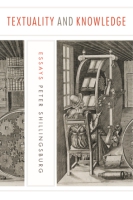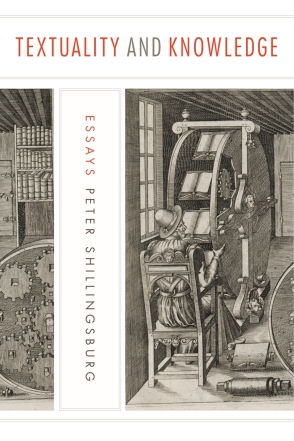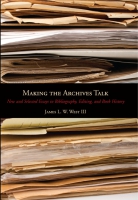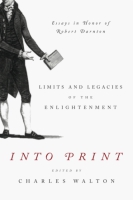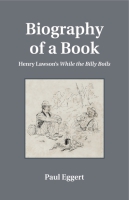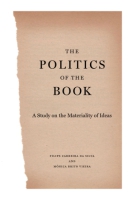Textuality and Knowledge
Essays
Peter Shillingsburg
“There are big issues at stake in this restless symposium of a book, for it is brave and honest. Every research library serving the humanities needs to order a copy of it, and textual scholars will want to do so as well.”
- Description
- Reviews
- Bio
- Table of Contents
- Sample Chapters
- Subjects
Through thirteen essays, Shillingsburg argues that literary study depends on documents, the preservation of works, and textual replication, and he traces how this proposition affects understanding. He explains the consequences of textual knowledge (and ignorance) in teaching, reading, and research—and in the generous impulses behind the digitization of cultural documents. He also examines the ways in which facile assumptions about a text can lead one astray, discusses how differing international and cultural understandings of the importance of documents and their preservation shape both knowledge about and replication of works, and assesses the dissemination of information in the context of ethics and social justice. In bringing these wide-ranging pieces together, Shillingsburg reveals how and why meaning changes with each successive rendering of a work, the value in viewing each subsequent copy of a text as an original entity, and the relationship between textuality and knowledge.
Featuring case studies throughout, this erudite collection distills decades of Shillingsburg’s thought on literary history and criticism and appraises the place of textual studies and scholarly editing today.
“There are big issues at stake in this restless symposium of a book, for it is brave and honest. Every research library serving the humanities needs to order a copy of it, and textual scholars will want to do so as well.”
“Records the thinking of one of our strongest editorial theorists as the study of the book bent—or did not bend—to the winds of change during the first decade of the millennium.”
“Shillingsburg’s insistence that we insist on the importance of provenance in our classrooms and editions is timely, urgent and — as we would expect — supported by the soundest available textual evidence.”
Peter Shillingsburg was the first Martin J. Svaglic Professor of English and Textual Studies at Loyola University Chicago. He is the author of five books, most recently From Gutenberg to Google: Electronic Representations of Literary Texts.
Contents
Introduction and Acknowledgements
1 The Evidence for Literary Knowledge
2 Textual Criticism, the Humanities, and J. M. Coetzee
3 The Semiotics of Bibliography
4 Some Functions of Textual Criticism
5 Long Distance Revision
6 Text as Communication
7 The Archive and the Critical Edition: Intentions Revisited
8 How Literary Works Exist
9 Convenient Scholarly Editions
10 Scholarly Editing as a Cultural Enterprise
11 Work and Text in Non-Literary Text-Based Disciplines
12 Publishers' Records and the History of Book Production
13 Cultural Heritage, Textuality, and Social Justice
Bibliography
Introduction
Sound evidence undergirds knowledge, unsound evidence cannot lead to or support knowledge—except by accident; that maxim distinguishes knowledge from speculation, belief, hope, superstition, and demonstrable falsehood. In literary studies, all evidence is textual. It depends on documents, document preservation, and textual replication. Interpretive strategies are for understanding the evidence. Of any proposition in literary history one asks first, How do you know? and, What is the evidence? Once evidence is produced, the first question to ask is, Where did that come from? Only when one knows what one is examining does it make sense to explore the associated questions about contexts of writing and publication, effects on readers, and probable or plausible intentions for the purposes, meanings, or significance of texts.
To address these questions, one needs not only original documents but a discipline for understanding them. That discipline is textual criticism. Textual criticism investigates what passes for knowledge of the past, and what passes for sound interpretive opinions about the past. Textual criticism is fundamental to literary criticism and literary history. Together these fields mark the boundaries of book history, including investigations of manuscripts and digital materials, which together constitute the history of documents and texts and of the means of their production, dissemination, consumption, and preservation.
As I suggest in the essay on the novelist J. M. Coetzee, later in this volume:
Textual criticism, focusing on the material, semiotic, communicative, and provocative elements of text, provides a fundamental act of self-examination and cannot be skipped over in studia humanitatis. Texts are the material and substance that condition all knowledge and all beliefs. The critical investigation of texts as text, operating in a textual condition and thus affecting human interaction, is the fundamental studia humanitatis.
Lest one think that the discipline of textual criticism and a burning interest in ferreting out and verifying sources can solve the riddle of the connection between textuality and knowledge, it should be noted that no one ever read the original of any literary work; one can only read a copy—manuscript, proof, or print—each is a copy or a copy of a copy. None, not even the first copy, is the original. We work at an unbridgeable distance from the object of our attention. Is it a book? Is it a text? Is it a work? What are the consequences of that gap? Does it give us freedom to think and say anything we want? or, Does it impose a responsibility to be met thoughtfully?
The Plan
The essays in this collection are about the relationship between textuality and knowledge. Though written over a period of time for a variety of venues, they all contribute to that central idea. Textual awareness, or lack thereof, affects teaching, reading, and research. The first essay lays out the general functions of textual criticism for non-specialist students and critics, emphasizing the interpretive consequences of textual variation and the value of textual awareness. The second essay explores further the role of textual criticism in the history of humanistic study, demonstrating the interpretive consequences of major revisions in a sample work (J. M. Coetzee's Elizabeth Costello). Essay three takes up a contentious debate of the last quarter century in textual studies: the meaning of the bibliographical condition (the physicality) of literary texts. Although this chapter argues the issues technically and explores what some might consider scholarly internecine warfare, its primary point is that students and literary critics are affected both overtly and subliminally by the physicality of texts. The next essay exposes the role of editors in shaping the works that readers encounter. Readers are at the mercy of editors, who frequently intervene to disambiguate and to correct apparent errors, often enough without due regard to the original text's potential. Essay five consists of two case studies demonstrating the ambiguities and uncertainties that prevent editors from knowing exactly what to do, showing that knowledge of a text's genesis often reveals nuances and richness not available from the well-edited single text presented as a finished product. The sixth essay follows from the case study, developing the idea that literary texts, at some level, are communicative and that editors (and indeed readers generally) frequently rely on their sense of coherence in language use to detect errors and substitute corrections that provide a more satisfying communicative experience. That fact reveals as much as anything the distinction between the book (document) and the work (the verbal, conceptual art). Essay seven examines the capacity of texts to be communicative by exploring the old conundrum of authorial intentions, adding the intentions of editors, publishers, and readers to the mix. Having explored a number of areas of difficulty, uncertainty, and the impossibility of correctness, the next essay attempts of define and describe the ways in which literary works exist, developing earlier notions of the work as a conceptual entity, as material objects, and as experienced events. Each aspect of textual existence has editorial consequences and, hence, reader consequences. And yet, editors, publishers, and readers need and desire "convenient" editions, paperbacks, books (with margins wide enough to accommodate annotations), or digital texts. The desire for convenience often entails a temptation to treat books as infinitely malleable in form but stable in content. Despite the interpretive value of genetic textual study, students, critics, and readers seldom demand the full picture, preferring convenience over comprehensiveness. The next two essays, ten and eleven, take up the fact that textual studies in different countries and in disciplines other than literature have followed trajectories different from that of Anglo-American textual studies. These essays attempt to show how multi-national and multi-disciplinary theory and practice in editing is informative and can influence the work of any single tradition. Essay twelve digs a bit deeper into the relationship between authoring and book production, illustrating the role of bibliographical and book history investigations in identifying as precisely as possible the text one is examining. It illustrates the lengths to which one can go to answer this book's fundamental questions about knowledge: Where did that come from? and How do you know? The final chapter reverts to the subject of the first essays: the relations among textual study, cultural studies and focuses attention on the ethical issue of social justice with regard to the generation and dissemination of textual knowledge. My aim in the whole is to explain the role of textual studies in literary studies. Any old text will not do, unless one does not care what it does.
The Gender and Politics of Knowledge
In the last quarter of the twentieth century, the study of literature explored with great enthusiasm and intellectual profit the proposition that disinterested knowledge—knowledge that purported to be unassailable because of its comprehensive grounding in verifiable evidence and because it rejected overt political biases and agendas—was in fact deeply committed to biases and political agendas related to the "mainstream" sense of self. Unacknowledged political agendas of disinterested pursuits of knowledge were, it became widely thought, designed to protect the status quo power structures in academe and in society. One result of the rebellion against disinterested, but actually self-interested, scholarship, was to pursue openly a vast array of interests and agendas, both in the original literary texts and in the scholarship purporting to elucidate such works. Among the most valuable ensuing developments was women's studies, post-colonial studies, gay and lesbian studies, and ethnic studies. In this book, it might have been good to illustrate the relationship between textual knowledge and these overtly political approaches to literature. I have not done that. The central concern of this book is not the writings by men or women or minorities. Instead, my central concern is the value, indeed necessity, of determining the relationship between the texts one is using and the knowledge one purports to support by reference to them. The principles I am exploring are, I believe, the same regardless of the gender, geography, ethnicity, or temporal placement of a writer. The relation between documents as evidence and criticism as argument is without gender, nationality, time, or place. In order to keep my illustrations from being a litany of he said she said hearsay evidence I had to confine my illustrations to textual histories that I had examined first hand. There are four case studies in this book, extended illustrations from the works of a twentieth century English woman, Virginia Woolf, a living South African, J. M. Coetzee, and a nineteenth century Englishman, William Makepeace Thackeray. There are many other references to smaller points in the textual histories of other writers, many more of them men than women. But my concern is with the relationships between evidence and knowledge and that is not, per se, a gendered or political issue, though the criticism that is based upon that knowledge probably is. I do not know how to illustrate one relationship between document and knowledge that holds true for the writings of women and a different one that holds true for the writings of men. I do, however, show the consequences of ignoring, or of being aware of, the importance of documentary evidence in critical arguments.
Dedication and Acknowledgements
I dedicate this book to those scholars who introduced me to international textual studies: H.T.M. (Dick) Van Vliet led me to Historical / Critical Editing, which has such sway in the Netherlands and Germany—road trips with Dick to Amsterdam, The Hague, Lingen, Aachen, Leuven, and Munster extended opportunities to dispute textual issues; Sukanta Chaudhuri opened for me Bengali editorial issues and goals—particularly in a week-long seminar in Santiniketan to plan an edition of Rabindranath Tagore's works ; Harry Heseltine and Paul Eggert encouraged my thinking about editing in Australia—particularly the recovery and editing of Colonial Australian literary works; John Gouws exposed me to the very difficult range of issues facing South African textual criticism in multiple languages—an unforgettable four-day trip with Gouws and Eggert on Australia’s Great Ocean Road focused attention on the ethics of editing; and Kiyoko Myojo and Christian Wittern initiated my acquaintance with Japanese and Chinese textual problems—and demonstrated the compatibility between peripatetic textual seminars and Japan’s exquisite museum of printing, a bullet train, ancient architecture and gardens, and good eating. Having drawn so much from these very generous scholars I am happy to claim deep friendship with them as well.
Other scholars have contributed significantly to my thinking about texts and criticism. My major professor James B. Meriwether put me on the career track that has brought me to this point. James L. W. West III, editor of this series, has given valuable editorial advice. Peter Robinson is an inspiration in the area of digital texuality and was responsible for moving me to England in 2003, thus enabling my participation in the European Society for Textual Scholarship, where I encountered a refreshing and challenging range of new textual problems and rationales for textual criticism. George Bornstein and David Greetham have influenced my thinking over the years, though I see Paul Eggert's hand and ideas in most of what I write. G. Thomas Tanselle and James Thorpe, serving on the Modern Language Association’s Committee on Scholarly Edition while I was its coordinator in 1976-77, set for me a standard in the art of civil disagreement and persuasion. All of textual criticism and scholarly editing owes incomparable debts to Fredson Bowers and Jerome McGann for making us think, rethink, and push forward our ideas about texts and textuality.
I began this book as a collection of lectures and essays, thinking it would be a relatively simple act of gathering mementos of the occasions that stimulated them. Jim West and Paul Eggert commented on the original copy; serious cutting and reworking followed. I no longer care much for the origins of each chapter, except to cite them as starting points.
I am grateful for permission to reuse previously published work: Ch 8 incorporates materials first published in Digital Humanities Quarterly and in Text and Genre in Reconstruction (Open Book Publishers); Ch 2 first appeared in English Studies in Africa; and Ch 12 is based in part on work published by University of Virginia Press and Palgrave. Thanks to The Society of Authors as the Literary Representative of the Estate of Virginia Woolf for permission to photo-quote, in Ch 5, passages from the proofs and early editions of To the Lighthouse.
A special note of thanks goes to Nicholas Hayward for partnering with me to create the Woolfonline project and preparing the photo-quotes for this book.
My deepest debt is, however, to my friend, colleague and wife, Miriam C. Jones Shillingsburg, who among other things learned how to apply computing to text collation and pushed development of CASE (Computer Assisted Scholarly Editing) programs , which I, and a significant number of other editors, have used for over thirty years to investigate textual histories and to prepare scholarly editions.
Mailing List
Subscribe to our mailing list and be notified about new titles, journals and catalogs.
